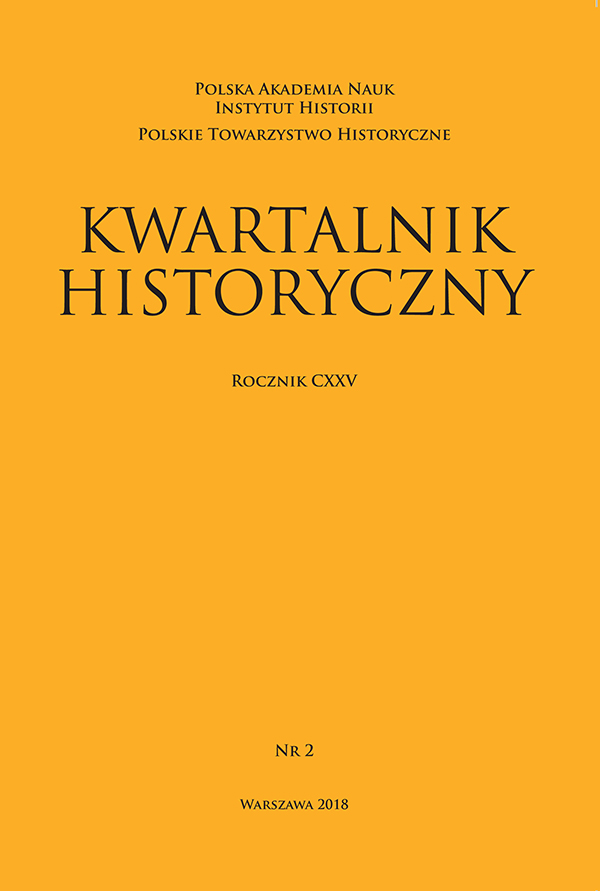Karty na stół. Geografia i granice nowej Europy po I wojnie światowej
DOI:
https://doi.org/10.12775/KH.2018.125.2.06Słowa kluczowe
geografia, terytorium, I wojna światowa, konferencja pokojowa w Paryżu, granice, geography, territory, First World War, Paris Peace Conference, bordersAbstrakt
Tematem artykułu jest udział geografów w dyskusji nad nowymi granicami Europy Środkowo-Wschodniej i Południowo-Wschodniej w czasie I wojny światowej i na konferencji pokojowej w Paryżu. Na przykładzie uczonych takich jak Jovan Cvijić, Eugeniusz Romer, Stepan Rudnic’kyj i Viktor Dvorský autor analizuje strategie argumentacyjne towarzyszące tworzeniu definicji terytorium narodowego. W dalszej części tekstu zajmuje się wpływem ekspertów geograficznych na ustaleniakonferencji pokojowej w Paryżu w 1919r.
The article discusses the contribution of geographers to the discussion about the new boundaries of East-Central and South-Eastern Europe during the First World War and the peace conference at Paris. Using the examples of such scholars as:Jovan Cvijić, Eugeniusz Romer, Stepan Rudnytskyi and Viktor Dvorský, the author analyses the argumentative strategies used to formulate the definition of national territory. In the further part of the text he focuses on the contribution of experts in geography to the output of the Paris Peace Conference of 1919.
Bibliografia
Bariéty Jacques, Le Comité d’Études du Quai d’Orsay et les frontiers de la Grande Roumanie, 1918–1919, „Revue Roumaine d’Histoire” 35, 1996, 1–2, s. 43–51.
Boulineau Emile, Les géographes et les frontières austro-slovènes des Alpes orientales en 1919–1920, „Revue de Géographie Alpine” 2001, 4, s. 173–184.
Boulineau Emile, Un géographe traceur de frontières. Emmanuel de Martonne et la Roumanie, „L’Espace géographique” 2001, 4, s. 358–369.
Cehelskyj Longin, Die großen politischen Aufgaben des Krieges im Osten und die ukrainische Frage, Kroll, Berlin 1915.
Cvijić Jovan, La Péninsule Balkanique. Géographie humaine, Colin, Paris 1918.
Die tschechoslowakischen Denkschriften für die Friedenskonferenz von Paris 1919/1920, oprac. Hermann Raschhofer, Heymann, Berlin 1938.
Dmowski Roman, Polityka polska i odbudowanie państwa, t. 2, oprac. Tomasz Wituch, Pax, Warszawa 1988.
Dvorský Viktor, Území českého národa, Český čtenář, Praha 1918.
Ekspertyzy i materiały delegacji polskiej na konferencję wersalską 1919 roku, oprac. Marta Przyłuska-Brzostek, PISM, Warszawa 2009.
Ginsburger Nicolas, Réseaux académiques et circulations savantes entre guerres et paix (1912–1919). Les expertises de Jovan Cvijić et de ses collègues géographes à travers les cas de Trieste et Fiume, „Cybergeo. European Journal of Geography” 2016 (https:// cybergeo.revues.org/27690).
Górny Maciej, Wielka Wojna profesorów. Nauki o człowieku (1912–1923), IH PAN, Warszawa 2014.
Hanak Harry, Great Britain and Austria-Hungary during the First World War. A Study in the Formation of Public Opinion, Oxford University Press, London 1962.
Hausmann Guido, Das Territorium der Ukraine. Stepan Rudnyc’kyjs Beitrag zur Geschichte räumlich-territorialen Diskurs über die Ukraine, w: Die Ukraine. Prozesse der Nationsbildung, red. Andreas Kappeler, Böhlau, Wien 2011, s. 145–157.
Herb Guntram H., Under the Map of Germany. Nationalism and Propaganda 1918–1945, Routledge, London–New York 1997.
Hronský Marián, Boj o Slovensko a Trianon 1918–1920, Národné literárne centrum, Bratislava 1998.
Jureit Ulrike, Das Ordnen von Räumen. Territorium und Lebensraum im 19. Und 20. Jahrhundert, Hamburger Edition, Hamburg 2012.
Kapras Jan, O českém státě za války a po válce (soubor článků), Český čtenář, Praha 1925.
Konopczyński Władysław, Dziennik 1918–1921, cz. 1, oprac. Piotr Biliński, Paweł Plichta, Muzeum Historii Polski, Ośrodek Myśli Politycznej, Warszawa–Kraków 2016.
Lansing Robert, Die Versailler Friedens-Verhandlungen. Persönliche Erinnerungen, Hobbing, Berlin 1921.
Lundgreen-Nielsen Kay, The Polish Problem at the Paris Peace Conference. A Study of the Policies of the Great Powers and the Poles, 1918–1919, Odense University Press, Odense 1979.
Lyde Lionel W., Types of Political Frontiers in Europe, „The Geographical Journal” 45, 1915, 2, s. 126–139.
Macartney Carlile Aylmer, Hungary and Her Successors. The Treaty of Trianon and Its Consequences 1919–1937, Oxford University Press, Oxford 1937.
Ng Amy, A Portrait of Sir Lewis Namier as a Young Socialist, „Journal of Contemporary History” 40, 2005, 4, s. 621–636.
Palsky Gilles, Emmanuel de Martonne and the Ethnographical Cartography of Central Europe (1917–1920), „Imago Mundi” 54, 2002, s. 111–119.
Pasierb Bronisław, Polskie prace przygotowawcze do Traktatu Pokojowego z Niemcami 1916–1948. Instytucje – ludzie – problemy, Wydawnictwo Uniwersytetu Wrocławskiego, Wrocław 1996 (Acta Universitatis Wratislaviensis No. 1803, Politologia 18).
Romer Eugeniusz, Pamiętnik paryski (1918–1919), oprac. Andrzej Garlicki, Ryszard Świętek, Ossolineum, Wrocław 1989.
Rudnyćkyj Stephan, Der östliche Kriegsschauplatz, Diederichs, Jena 1915.
Rudnyćkyj Stephan, Ukraina und die Ukrainer, Verlag des Allgemeinen Ukrainischen Nationalrats, Wien 1914.
Rudnyćkyj Stephan, Ukraina. Land und Volk. Eine gemeinfassliche Landeskunde, Bund der Befreiung der Ukraina, Wien 1916.
Seegel Steven, Mapping Europe’s Borderlands. Russian Cartography in the Age of Empire, University of Chicago Press, Chicago–London 2012.
Seymour Charles, Letters from the Paris Peace Conference, oprac. Harold B. Whiteman, Jr., Yale University Press, New Haven–London 1965.
Sibora Janusz, Dyplomacja polska w I wojnie światowej, PISM, Warszawa 2013.
Sluga Glenda, The Nation, Psychology, and International Politics, 1870–1919, Palgrave, Basingstoke 2006.
Stebelski Ihor, Putting Ukraine on the Map. The Contribution of Stepan Rudnyts’kyi to Ukrainian Nation-Building, „Nationalities Papers” 39, 2011, 4, s. 587–613.
Ter Minassian Talinne, Les géographes français et la délimitation des frontières balkaniques à la conférence de la paix en 1919, „Revue d’histoire moderne et contemporaine” 44, 1997, 2, s. 252–286.
Żurawski vel Grajewski Przemysław, Sprawa ukraińska na konferencji pokojowej w Paryżu w roku 1919, Semper, Warszawa 1995.
Штoйкo Пaвлo, Cтeпaн Pyдницкий 1877–1937. Життeпиcнo – бiблioгpaфiчний нapиc, HTШ, Львiв 1993.
Pobrania
Opublikowane
Jak cytować
Numer
Dział
Statystyki
Liczba wyświetleń i pobrań: 325
Liczba cytowań: 0



